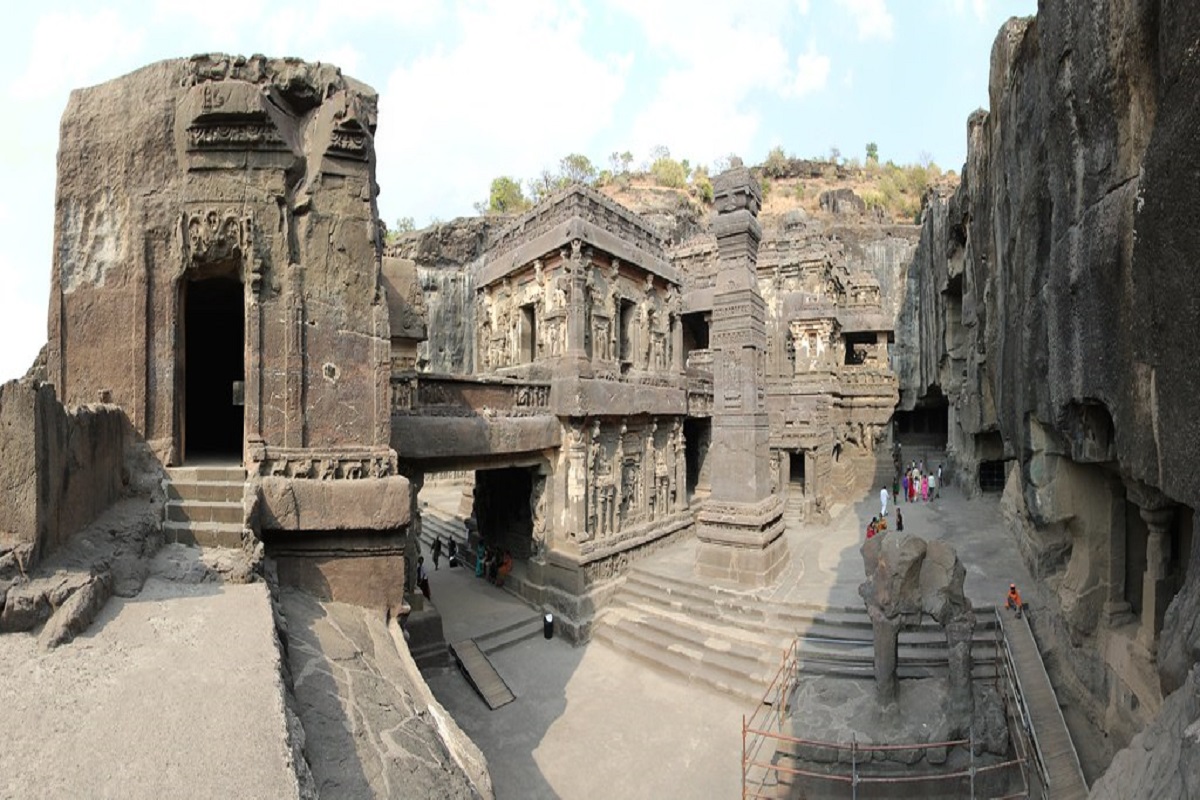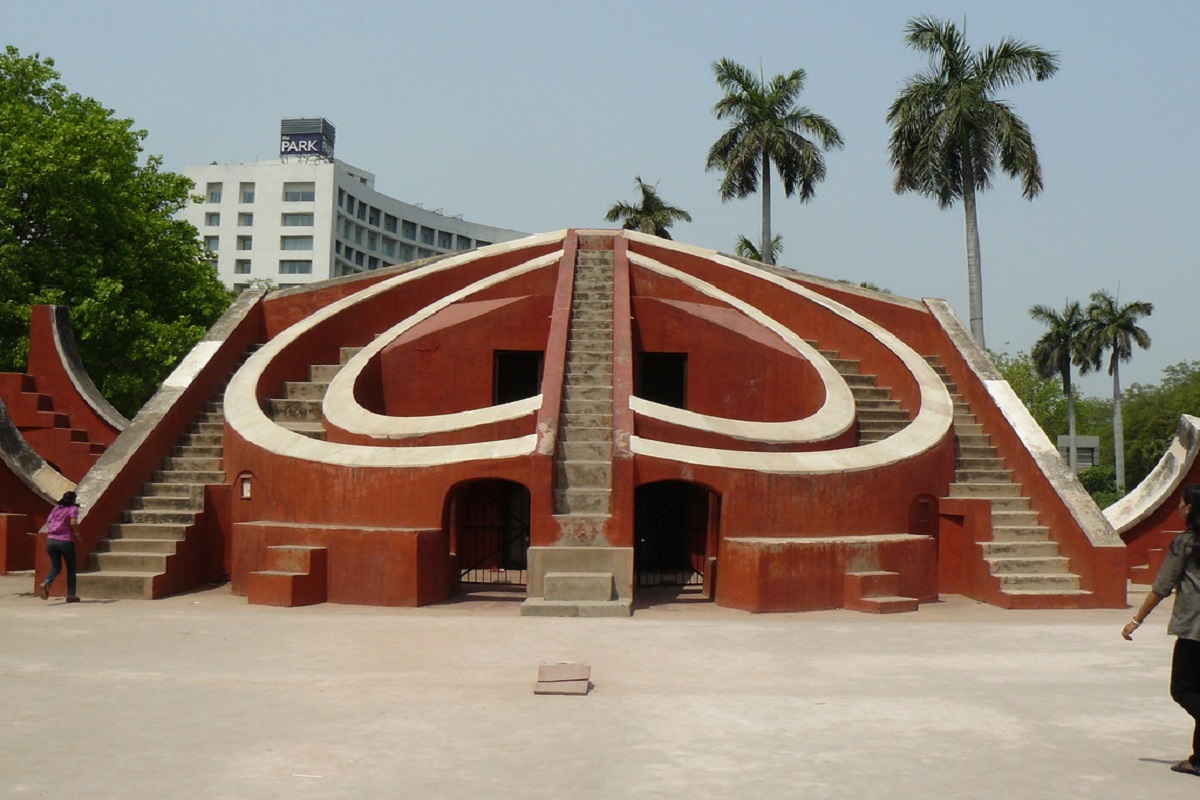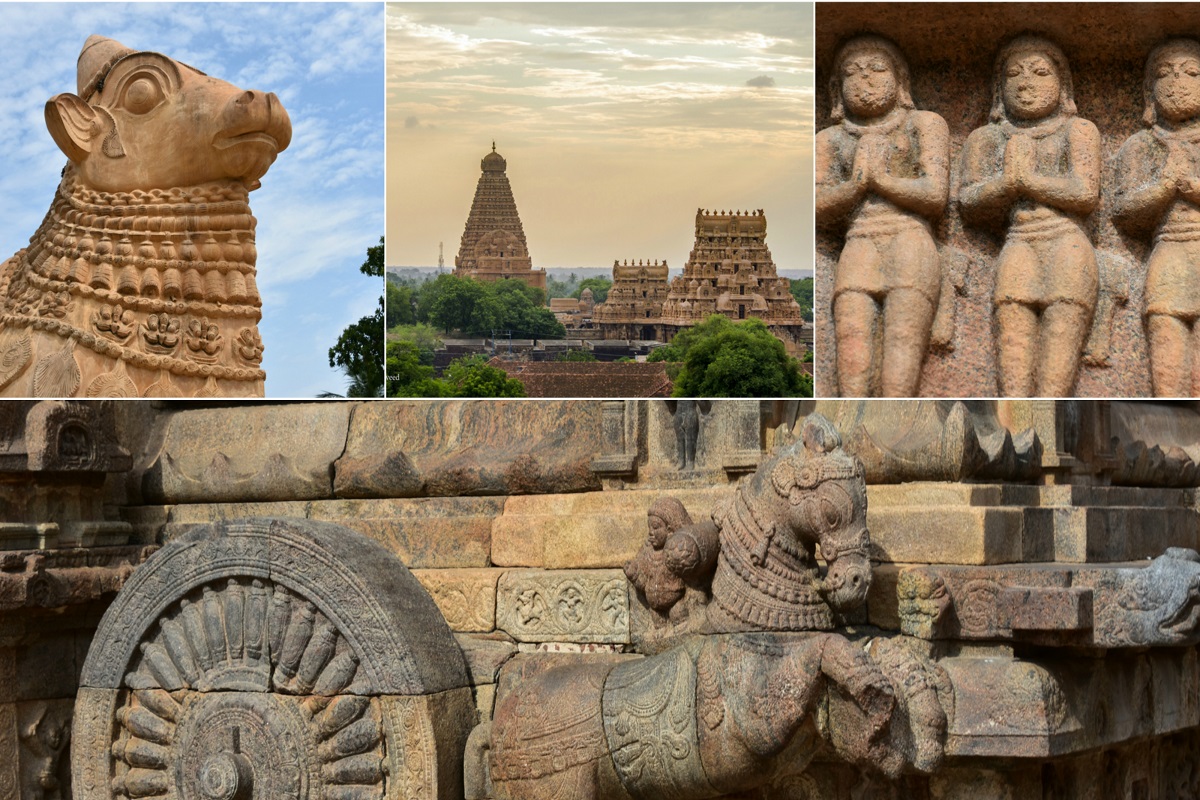The Ellora caves are one of the most popular historical tourist locations in the Aurangabad district. Declared as one of the UNESCO World Heritage Sites the Ellora caves happens to be one the biggest monastery temple caves cut out of rocks.
The caves and the paintings and sculptures with features Buddhist, Hindi and Jain artwork and monuments. These caves were created between the passages of 600 to 1000 CE. The Ellora Caves happens to be a standing epitome of the communal and religious harmony that must have existed in ancient India.
Ellora Caves Built By
Although the opening of the discussion gives a rough idea of the time frame within which the cave complex must have been commenced and then completed, yet there remains much ambiguity regarding the exact dates of the caves. There is much confusion regarding the fact that which of the caves came first – the Buddhists, the Hindus or the Jains. Further there is also a confusion regarding the date chronology of the caves in each of the religious sub-sects.
There are more than 100 caves in the site. Out of them, 34 have been opened for the general public to see. 12 caves are of Buddhist origin, 17 ones happen to be Hindu in their features and paintings and 5 are Jain. The Hindu and the Buddhist caves were developed by the Rashtrakuta dynasty. Similarly the Yadava Dynasty is credited with the construction of the Jain caves. The funding of these caves came from the royal patrons, the wealthy traders and businessmen and the affluent people of the region.
Ellora Caves Timing

The Ellora caves are open round the year even on holidays. You can plan a visit to the site any day of the week except Tuesdays, when they site is closed for the visitors. The caves are open for the tourist from morning 6 to evening 6. The day hours are the best time to visit the place. This is when you can examine all the paintings and the sculptures and other architecture of the caves.
Visiting the place after sunset will be of no use. It can even be a little dangerous. Ellora caves are quite elaborate in its dimensions. Visitors will have a lot of things to see and explore. Hence it is advisable that you visit the place with a minimum of two to three hours in hand.
Ellora Caves Facts
The Ellora Caves is considered to be one of the most important tourist attractions of the Marathwada Region. It is located about 18 miles north west of Aurangabad and also 190 miles east north east of the commercial city of Mumbai. The site is under strict protection from ASI.
The Ellora caves are situated along the rocky range of the Western Ghats. The ancient volcanic movements have led to the emergence of the several layered basalt land forms. They are also referred to as the Deccan Traps. Several scholars have opined that the Ellora Caves had attained importance in various ages like the Early Hindu age from 550 to 600 CE, the Buddhist period from 600 to 730 CE and a later Hindu and Jain phase from 730 to 950 CE. The very first of these caves were probably built as early as the reigning periods of the Traikutakas and the Vakataka Dynasties.
The Vakatakas have also been credited with the construction and the development of the Ajanta Caves. However some of these Ellora caves like the 29 cave were constructed b the Kalachuri Dynasty who was the followers of Lord Shiva. Some of the Buddhist caves can also be attributed to the Chalukya Dynasty. The Rashtrakuta dynasty can be attributed with the construction of the Jain and the later Hindu caves.
Unveiling the Ellora Caves Age

The Ellora Caves construction occurred over several centuries, with the earliest caves dating back to the 6th century CE and the latest ones completed by the 10th century CE. This site is a treasure trove of rock-cut temples, monasteries, and caves that beckon travelers and history enthusiasts alike. The Ellora Caves, a mesmerizing testament to ancient artistry and architectural prowess, stand proudly as a UNESCO World Heritage Site in the Indian state of Maharashtra.
Understanding the Ellora Caves Age
The Ellora Caves, situated near the Aurangabad district in India, boast a rich heritage that spans a vast timeline. Carved painstakingly into the Charanandri Hills, these caves showcase a blend of Hindu, Buddhist, and Jain influences.
Origins and Historical Significance
- Buddhist Caves (Caves 1-12)
The earliest caves at Ellora predominantly feature Buddhist monuments, known for their simple yet elegant designs. These caves, notably Cave 5 (Maharashtra’s largest monastery), illustrate the life of Buddha through intricate sculptures and reliefs.
- Hindu Caves (Caves 13-29)
Transitioning from the Buddhist caves, Ellora’s Hindu caves are epitomes of architectural marvels. The Kailasa Temple (Cave 16), an awe-inspiring monolith, stands out. It’s believed to have been excavated from top to bottom, showcasing remarkable craftsmanship.
- Jain Caves (Caves 30-34)
The Jain caves, though fewer in number, are no less captivating. They exude serenity and elegance through their intricately carved columns and sanctums dedicated to Jain Tirthankaras.
Evolution of Architecture and Artistry in Ellora Caves
Architectural Styles
Ellora’s caves serve as a canvas reflecting the evolving architectural styles across centuries. From the simplicity of early Buddhist caves to the grandeur of the Kailasa Temple, the site showcases the evolution of architectural techniques and aesthetics.
Sculptural Marvels
The caves’ interiors are adorned with an array of sculptures, depicting religious deities, mythological tales, and daily life scenes. These sculptures not only exhibit exceptional craftsmanship but also provide invaluable insights into ancient cultures and beliefs.
Preservation Efforts and Contemporary Significance
Preservation Challenges
Over the years, Ellora has faced numerous challenges due to natural elements and human interventions. Preservation efforts by archaeological authorities and local communities aim to safeguard these historical marvels for future generations.
Cultural and Touristic Importance of Ellora Caves
Ellora Caves attract visitors worldwide, serving as a cultural hotspot and pilgrimage site. The site not only offers a glimpse into India’s rich heritage but also fosters an appreciation for ancient art and spirituality.
The Ellora Caves, with their diverse religious influences and architectural splendor, stand as a testament to human ingenuity and creativity across centuries. They serve as a bridge connecting us to our rich cultural heritage and remain an eternal source of inspiration for generations to come.
Ellora Location & How to Reach

Ellora Cave holds immense significance and beauty, drawing visitors from across the globe to witness its architectural marvels. Let’s dive into discovering the location of Ellora and the various routes one can take to reach this enchanting place.
Exploring Ellora’s Geographic Placement
Ellora, nestled in the Indian state of Maharashtra, stands as a testament to ancient craftsmanship and cultural heritage. Its geographical coordinates position it approximately 30 kilometers from Aurangabad, a vibrant city known for its historical importance.
Embracing the Cultural Heritage
Ellora, a UNESCO World Heritage Site, boasts a remarkable amalgamation of rock-cut caves showcasing religious diversity and architectural brilliance. The site’s magnetic appeal lies in its collection of Buddhist, Hindu, and Jain cave temples, showcasing a unique blend of artistic styles and spiritual significance.
Understanding the Routes to Reach Ellora
To embark on a journey to Ellora, various transportation modes offer convenience and accessibility. Let’s explore these routes:
By Air
The closest airport to Ellora is the Aurangabad Airport, which operates regular domestic flights connecting major cities like Mumbai and Delhi. Upon landing at Aurangabad Airport, travelers can opt for taxis or rental cars to cover the remaining distance to Ellora.
By Rail
For those preferring train travel, Aurangabad Railway Station serves as the nearest railhead to Ellora. Trains from major cities like Mumbai, Pune, Hyderabad, and Delhi connect to Aurangabad, providing an efficient railway network for visitors.
By Road
Roadways offer a picturesque journey to Ellora. State-run buses and private vehicles ply between Aurangabad and Ellora, offering a scenic drive through the captivating landscapes of Maharashtra.
Tips for a Seamless Journey
Planning a visit to Ellora involves a few key considerations to ensure a smooth and enjoyable experience:
Timely Planning
Given the historical significance and popularity of Ellora, planning your visit in advance is advisable. Checking for any seasonal variations in weather and tourist footfall can help in better scheduling.
Local Guidance
Engaging a local guide can enhance your exploration of Ellora. Their insights into the historical anecdotes and architectural nuances can enrich your visit and provide a deeper understanding of the site.
Ellora stands as a treasure trove of history and artistry, beckoning travelers to delve into its rich cultural heritage. Understanding its geographical location and the varied transportation options available ensures a delightful journey to this awe-inspiring destination.
Ellora’s allure lies not just in its architectural grandeur but also in the tales that echo within its ancient walls. As you plan your trip to Ellora, may the journey be as enchanting as the destination itself.
Remember, the journey to Ellora transcends mere travel; it’s a passage through time, unveiling the essence of India’s rich heritage.
As the allure of Ellora beckons, may your voyage be filled with wonder and discovery.
Entrance Fee:
The entrance fee to Ellora caves is rather nominal. The Indian tourist’s needs to pay Rs.10 and the foreign tourist’s needs to pay Rs.250. children below fifteen years can visit the caves for free. Video and Still camera will charge an extra Rs.25.
Ajanta Ellora Caves best time to visit

The winter season is considered to be the best to visit Ellora caves. Temperature falls till 10 degree and it is comfortable visiting the caves during this time. The months between November and February are considered to be the best to visit these caves and explore their beauty and historic marvels. However since the adjoining region boasts of lush greenery, you can also visit the place during the Monsoon months from July to September.
Ellora Cave Temple & Important Structures
The caves 1 to 12 are the Buddhist caves in this complex. They are often considered to be the oldest of the range and dates back to 630 to 700CE. Eleven out of the twelve caves happened to be the Viharas or the monasteries. They have huge prayer halls and were buildings with many storeys. These buildings were carved out of mountains and had sleeping quarters, living cells, kitchens, etc. these caves contains beautiful carvings of saints, Bodhisattvas and Gautama Buddha.
The Cave 10 deserves a special mention in this context. It is referred to as the Vishvakarma Cave which was developed as a Caitya or a worship hall. The cave is also known as the ‘carpenter cave’. The final finish of the rock has a wooden beam finish. The cave 10 wonderfully combines a worship hall and a vihara.
The caves 13 to 29 are the Hindu caves which were mainly constructed during the Kalachuri period. These caves hosts several important Hindu temples like the Dhumar Lena in cave 29, Rameshwar Temple in cave 21, the Kailsaha Temple in cave 16, the Dashavtara in cave 15, Ravan ki Khai in Cave 14, Nilkantha in cave 22, etc.
Caves 30 to 34 in the Ellora complex belonged to the Jain Digambara sect. the Jain caves happened to be smaller as compared to the Hindi and the Buddhist ones but contained really detailed and exquisite carvings. These caves featured things like symmetric mandapas, pillared verandah. The Jain caves depicted the 24 Jains, Jain deities and the human devotees.
Ellora Caves History

Located in the Sayhadri Mountains, the Ellora Caves are the second most important rock cut cave complexes found in India. The caves have a special historical significance, since they clearly depict a scenario of complete religious and communal harmony.
The Ellora caves is probably the only rock cut cave complex that exhibits architecture, paintings and sculptures from all the three different religions of Hinduism, Buddhism, and Jainism’s. All of them exist side by side. The caves and the paintings, sculptures and the inscriptions done on term clearly depict the fact that the royal patrons and the imperial rulers of the area played a major role in the development of these caves.
The wealthy people of the place contributed in the development of the caves. This is an indication of the fact that art, culture, painting, sculpturing etc. had a lot of significance in those days. Religion too happened to be an important part of the general lives. People were much invested in their divine deities.
Every different cave from all the three religious sects exhibits their own strain of architecture. The peaceful coexistence is surely a thing to learn even in the current times. The caves truly reflect the secular nature of the nation as a while. The rock cut caves also signifies the architectural prowess of the designers, architects and the mason of the age. All in all it is one of the most awe striking pieces of art and culture in India.
Attractions nearby Ellora Caves
Once you are done with exploring the Ellora caves make a note of the following places. Visit them as well to get a better insight into the rich history and culture of the place.
- A visit to the Ellora caves is never complete without seeing the Ajanta caves.
- Make a point to visit the Grishneshwar Jyotirlinga Temple. It is a mere three minutes walk from the Ellora caves.
- The next destination is Bhadra maruti. Again a celebrated Hindu temple of the region it is situated at a distance of 2.4 km.
- Merely at a distance of 25 minutes walking from Ellora caves is the Mughal Silk Bazaar. As the name suggests you get a collection of specialty and gift shops in the place. This is often considered to be a shopper’s paradise for local goods.
- Visit the Tomb of the Mughal emperor Aurangzeb which is at 2.4 km from the Ellora caves.
Before you plan a visit to the Ellora caves enquire about the Ganesh Chaturthi festival in the region. The Ellora caves hosts a love festival during this time of the year. The place becomes alive with popular culture and trade in the region.







